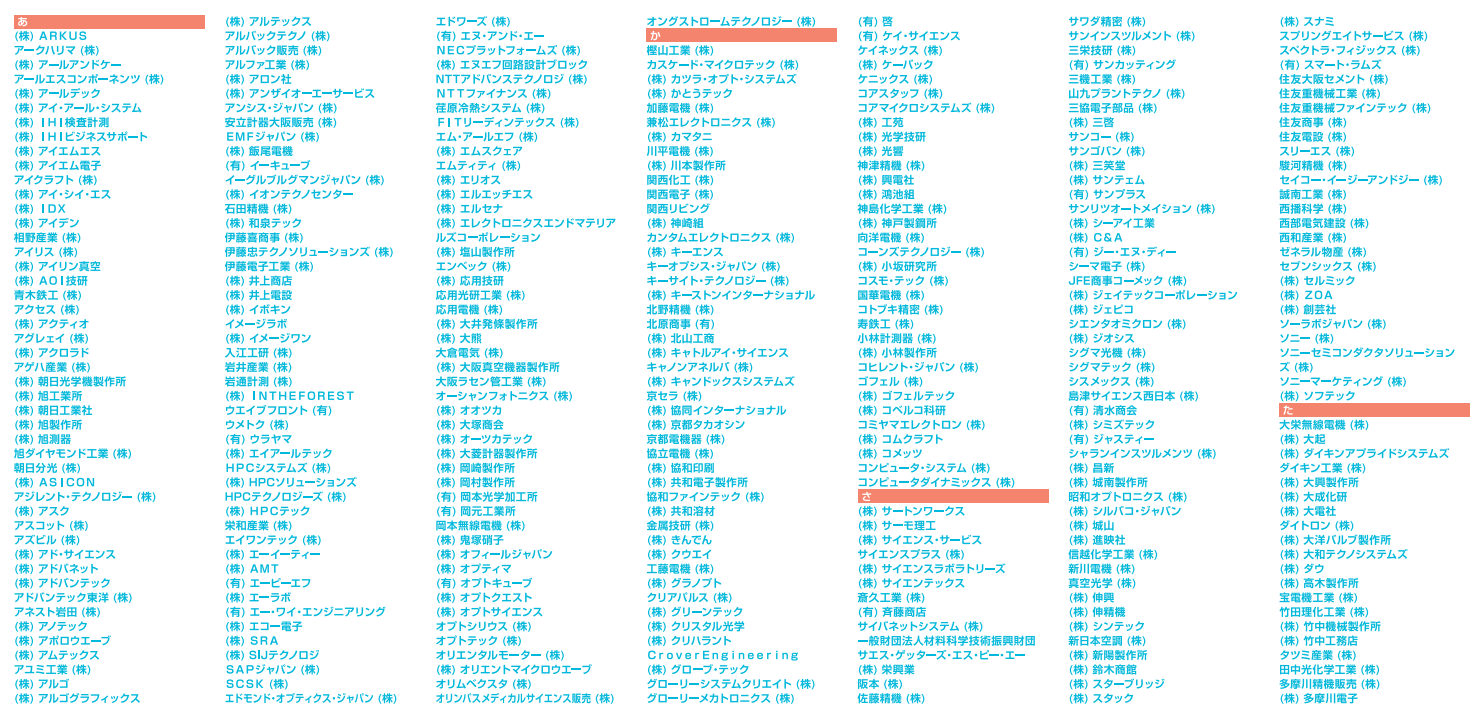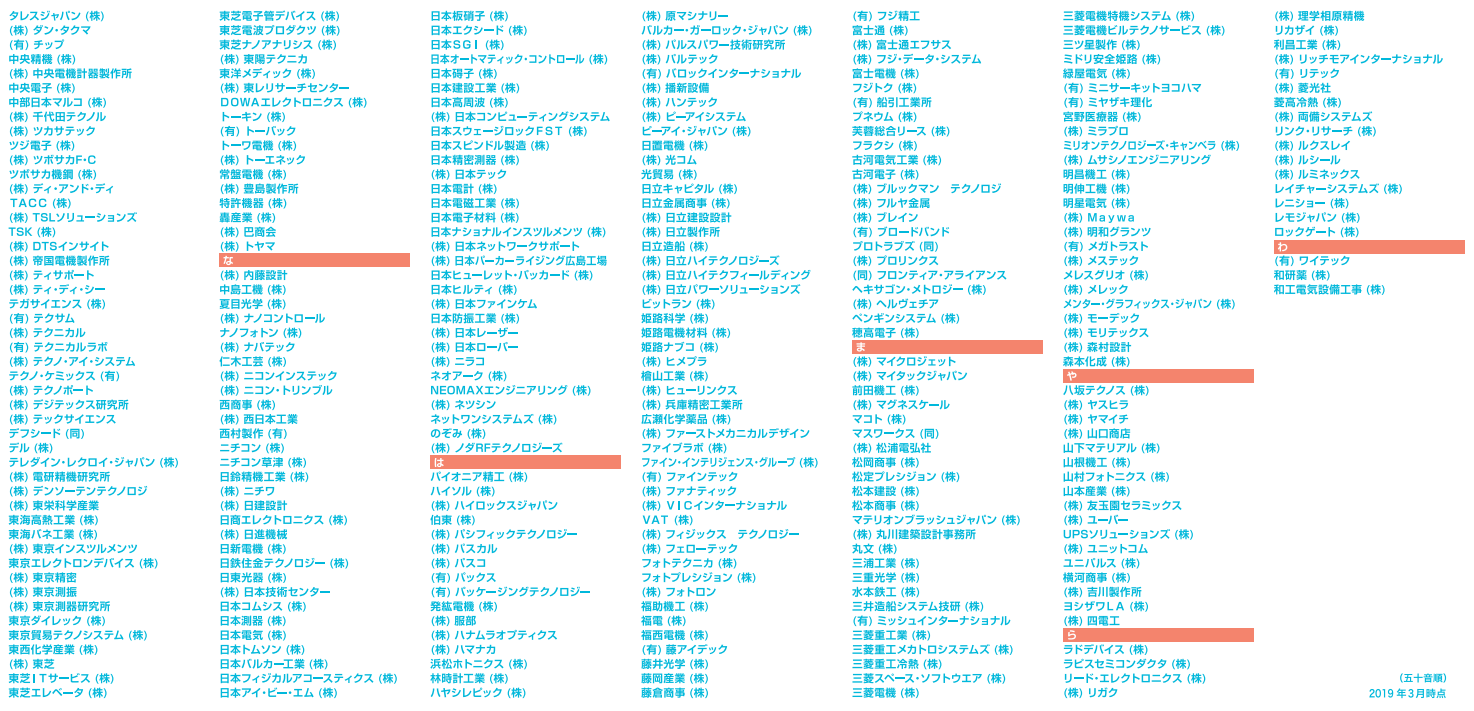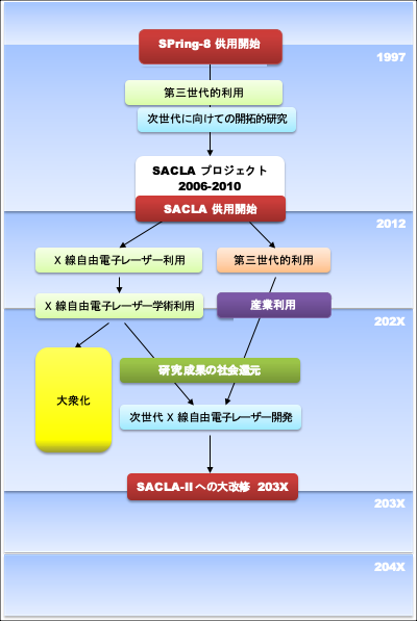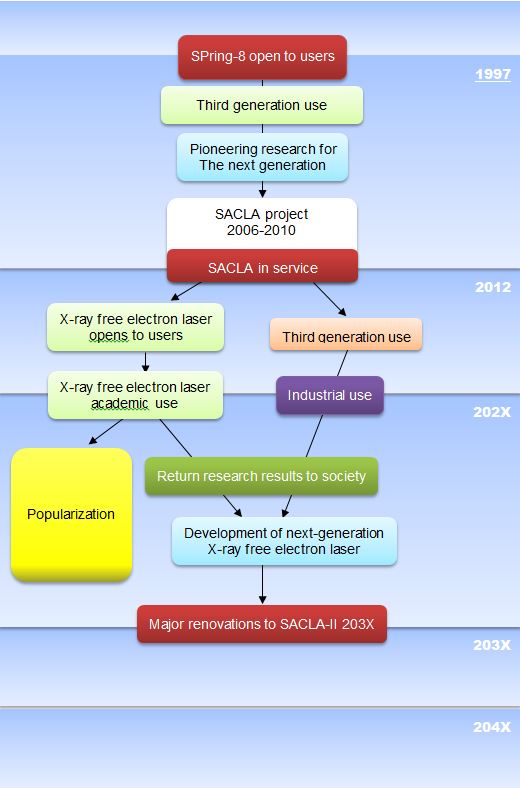SACLAとは
| 歴史 | どうやって作られた? | 放射光 | 仕組み | ビームライン | 将来 |

SPring-8レベルのX線では原子や分子の瞬間的な動きや変化を見るためには強度が足りません。そこで考案されたのがX線自由電子レーザー(XFEL)です。レーザー技術はDVDの読み取り装置や医療機器、溶接などさまざまな分野で活用されています。その光は指向性と収束性に優れていて、遠くの小さな対象物でもピンポイントで照らすことが出来ます。レーザーポインタと懐中電灯を思い浮かべれば、通常の光との違いはイメージできるでしょう。なぜそういう特性があるかというと、レーザーは光源から次々にでてくる光の波がぴったり揃っているからです。またレーザーは通常の光より短い時間にエネルギーを集中できるという特性(パルス特性)もあります。そこでX線をレーザー化し、両者の長所を備えた光を作ることで、あたかも超高速ストロボ写真のように、瞬間的な原子や分子の動きが捉えられるようになります。そのような光(X線自由電子レーザー)を作りだす施設がSACLAなのです。また、SACLAとSPring-8の間にある相互利用実験施設は、同じ敷地内にあることが世界的にも強みです。SACLAの強力な光をさまざまな材料に当て、変化する様子をSPring-8の光で観察するという実験によって、これまでに人類が見たことのない新しい現象が見られるかもしれません。SACLAの光は、想像を超える可能性を秘めています。
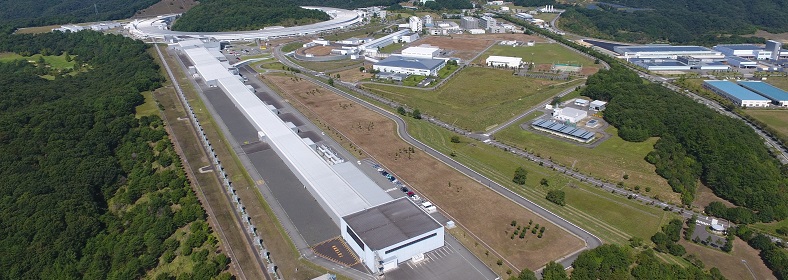
SACLAの歴史

| 2006年 3月 | 科学技術基本計画における国家基幹技術として選定、施設の建設・整備開始 |
| 2011年 3月 | 施設が完成、愛称は公募にて「SACLA」に決定 |
| 2011年 6月 | X線自由電子レーザーの発振に成功(世界最短波長0.12nm) |
| 2011年 7月 | 波長0.08nmのX線レーザー発振に成功 |
| 2011年10月 | 0.063nm(世界最短波長)のX線レーザー生成に成功 |
| 2012年 3月 | 供用運転開始、マルチビームライン開発着手 |
| 2013年10月 | グッドデザイン賞受賞「来るべき社会の礎を築くと認められる」グッドデザイン・未来づくりデザイン賞に選出 第42回日本産業技術大賞を理研播磨研究所他9団体が共同受賞(日刊工業新聞社主催) |
| 2016年 2月 | マルチビームライン化(2本のビームラインにX線レーザーを同時供給)に成功(世界初) |
SACLAはどうやって作られたか
SACLAの部品や装置は、ほとんどが日本のメーカーの高い技術によって作られています。その多くが、SPring-8の技術を元に開発されました。
SACLAの放射光
自然現象や生命活動の根源を探ると、その多くは原子や分子の並びかたや動き、そしてそれらの集まりの中での電子の動きまでさかのぼります。原子や分子の配列と動きや、電子の動きを直接観察できれば、難病の原因解明と薬の創出、地球環境を悪化させる物質の抑制方法の確立など、私たちの生活の向上に大きく役立つと期待されています。病院の診断でもおなじみのX線は、1895年にレントゲンによって発見されたもので、可視光に比べとても波長が短い光であることから、原子や分子のレベルで物質の微細構造を観察するのに利用されてきました。 SPring-8は世界で最も強いX線光源ですが、それでも原子や分子の瞬間的な動きを観察するためには強度が足りません。非常に強い光を出す光源としてレーザーがあります。X線のレーザーができれば、原子や分子の瞬間的な動きを観察することができます。レーザーは位相の揃ったコヒーレントな光(波の山と山、谷と谷が揃った光)を発生し、様々な光技術に応用されていますが、従来のレーザー技術の延長で波長の短いX線レーザーを作ることは不可能でした。X線でのレーザーを作る方式として、従来の物質中での発光現象を使う方式ではなく、電子を高エネルギー加速器の中で制御して運動させ、それから出る光を利用する方式が提案されました。原子からはぎ取られた自由な電子を用いてX線レーザーを作ることから、X線自由電子レーザー(X-ray Free Electron Laser : XFEL)と呼ばれます。このXFELによって、原子や分子の瞬間的な動きを観察することが可能となります。
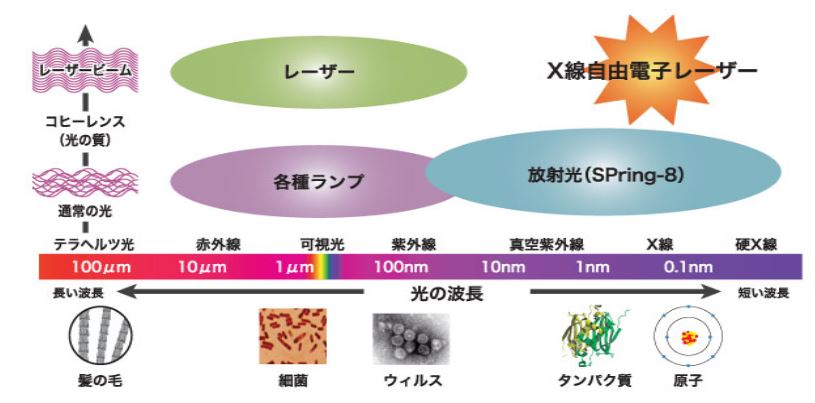
SACLAの仕組み
SACLAは、全長700mの細長い構造です。加速器棟(電子銃)、光源棟、そして実験研究棟(データ解析)からなります。
加速器棟の電子銃で発生させた電子は、全長400mの加速器によって最大で8GeV(80億電子ボルト)まで加速されます。全長240mの光源棟では、100mに及ぶ真空封止型アンジュレータにより電子を精密に繰り返し蛇行させ、X線自由電子レーザー(XFEL)を発生させます。このXFELはSPring-8の10億倍の明るさで、世界一短い波長をもちます。こうして発生させたXFELは実験研究棟の入口ハッチで加工され、その下流の実験ハッチでさまざまな実験に利用されます。
SACLAのビームライン

過飽和吸収実験イラスト
金粒子の回折
SACLAの将来
SPring-8は1997年に、SACLAは2012年に供用を開始しました。SPring-8は建設後ほぼ20年が最先端施設としての寿命と考えられ、世界で第一線級の施設であり続けるためには、2020年代にてSPring-8-Ⅱへの大改修は避けて通れません。SACLAもいづれ大改修が必要となります。SPring-8-Ⅱの大改修から20年後に予想されるSPring-8-Ⅲでは、リング型のX線自由電子レーザーが実現しているかもしれません。
What is SACLA?

The X-rays produced at the SPring-8 level lack the strength to witness the extremely rapid movements and changes of atoms and molecules. Therefore, the X-ray Free Electron Laser (XFEL) was devised.
Laser technology is used in various fields, from reading DVDs to medical equipment to welding. The light is excellent in directionality and convergence, and can be pinpointed even on small, distant objects. With normal light, you can think of the comparison between a laser pointer and a flashlight, and how the image illuminated changes depending on what you use.
The reason why such laser characteristics exist is that when the light is emitted from the laser, the succession of waves align perfectly with the laser source. Lasers also have the ability to concentrate energy in a shorter time than normal light (pulse characteristics). By lasing X-rays, and creating light that possesses the advantages of both, it becomes possible to capture the extremely rapid movement of atoms and molecules as if it were an ultra-high-speed strobe photograph.
SACLA is a facility that creates such light (X-ray free electron laser).
The XFEL-SPring-8 Experimental Facility is a world-class facility. Experiments to apply SACLA’s powerful light to various material and observe how they change from the light of SPring-8 may lead to new phenomenon undiscovered by mankind. SACLA’s light has more potential than we can imagine.

The History of SACLA

| March 2006 | Selected as a national core technology in the Basic Plan for Science and Technology, the construction and maintenance of the facility began. |
| March 2011 | The facility was completed and the public-offered facility acronym was chosen to be SACLA. |
| June 2011 | Successfully operated the X-Ray Free Electron Laser (World’s shortest wavelength of 0.12nm). |
| July 2011 | Successfully operated with an X-ray Laser wavelength of 0.08nm. |
| October 2011 | Generated an X-ray Laser wavelength of 0.063nm (Currently the record for the world’s shortest wavelength). |
| March 2012 | Began development and operation of multi-beamlines. |
| October 2013 | The facility was selected for the Good Design Award [Recognized as Building the Foundation of Society to Come] and the Novus Future Design Award. The RIKEN Harima Research Institute and nine other organizations jointly received the 42nd Japan Industrial Technology Award (Sponsored by Nikkan Kogyo Shimbun). |
| February 2016 | Successfully operated the world’s first Multi-Beamline (Simultaneously supplied X-Ray lasers to two beamlines). |
Synchrotron Radiation at SACLA
To gain understanding for the origins of natural and biological phenomena, we need to trace back to the way atoms and molecules are structured and function, and how electrons within them move. Directly observing the arrangements and movements of atoms, molecules and electrons is expected to greatly contribute to the improvement of human welfare. It would enable us to develop drugs for currently incurable diseases, treat harmful chemicals that damage our environment, and much more.
Discovered in 1895, X-rays are best known for their use in hospitals. Compared to visible light, X-rays have a much shorter wavelength, and therefore can be used to observe the microstructure of materials at the atomic and molecular level. SPring-8 is the most powerful source of X-rays in the world, but it still lacks the ability to observe extremely rapid movements of atoms and molecules.
Lasers, as a light source, emit exceedingly strong, concentrated light. With X-ray lasers, the extremely rapid movements of molecules and electrons become observable. Lasers generate phase-aligned, coherent light (waves with peak to peak and trough to trough) which can be applied to various optical technologies. However, short-wavelength, X-ray lasers have been out of reach of the technology of the day.
When X-ray lasers were proposed, they had to move away from traditional methods based on light-emitting properties of materials, and transition to a new way of accelerating electrons to high energies, then manipulating their movement to utilize the light emitted during the process. The name X-Ray Free Electron Laser (XFEL) was devised since it uses free electrons that have been stripped from atoms to produce the X-rays. This technology makes it possible to observe extremely rapid movement of atoms and molecules.

How SACLA works
SACLA is an elongated structure with an overall length of only 700m. It consists of an acceleration device (Electron gun), an undulator building, and an experimental facility (For data analysis).
After the electrons are generated by the accelerator building’s electron gun, an accelerator with a total length of 400m accelerates the electrons to a maximum of 8GeV (8 Billion electron volts).
The X-Ray Free Electron Laser (XFEL) consists of a 240m undulator building, where electrons pass through a series of alternating magnets in a 100m long in-vacuum undulator.
The XFEL generated in this way is processed in the inlet hatch of the experimental building and used in various experiments in the experiment hatch downstream.
The SACLA Beamline

| Illustration of a Supersaturated Absorption Experiment | Gold Particle Diffraction |
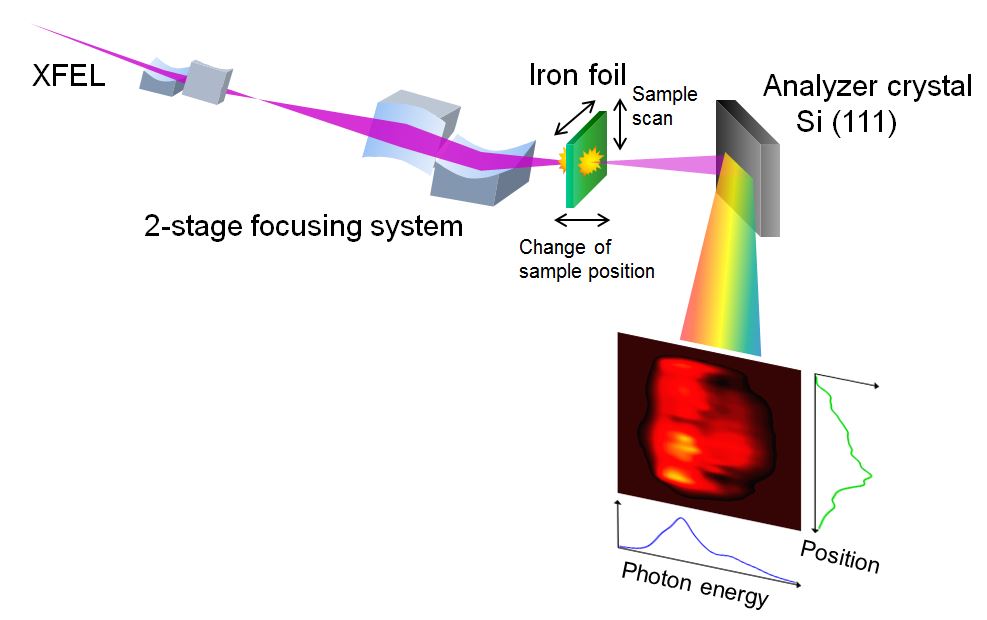 |
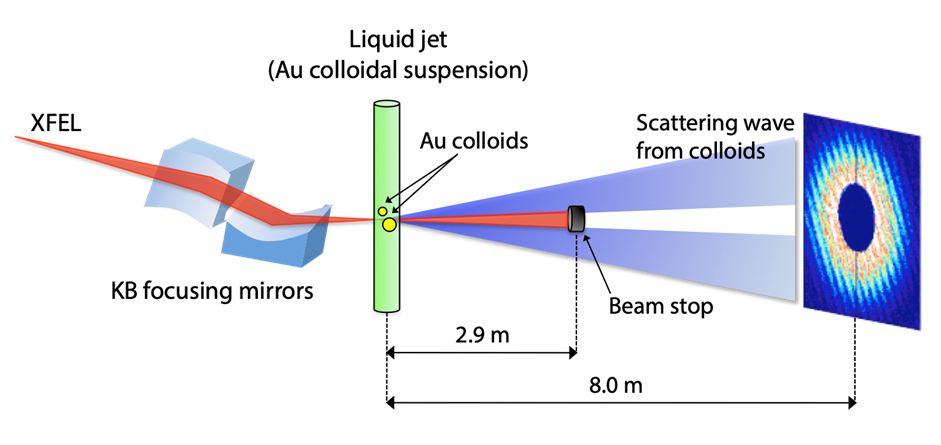 |
The Future of SACLA

